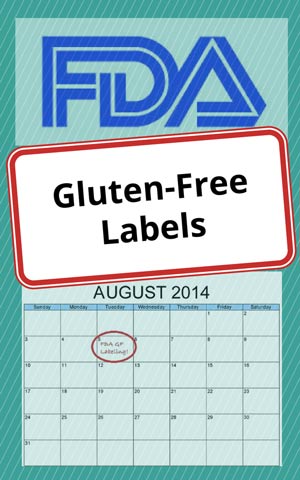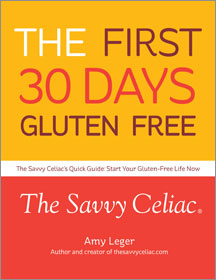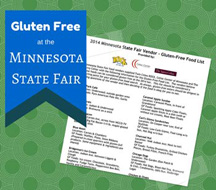10 Things to Know About the FDA’s Gluten Free Labeling Rule
August 1, 2014 by Amy Leger | G+ Amy Leger In just a few days, the Food and Drug Administration’s Gluten Free Labeling Final Rule goes into effect in the US.
In just a few days, the Food and Drug Administration’s Gluten Free Labeling Final Rule goes into effect in the US.
Bottom line, one-sentence description of the rule: Foods that fall under FDA’s jurisdiction must test below 20 ppm to be called gluten-free. The FDA’s rule is MUCH more detailed then that single sentence.
So we decided to break down a few of the top points about his rule and how it may affect you. The list is in no particular order.
10 Things to Know About the FDA’s Gluten Free Labeling Rule
1. This rule came from the the Food Allergen Labeling and Consumer Protection Act in 2004. FALCPA explained a gluten-free labeling rule should issued shortly thereafter. “Not later than 4 years after the date of enactment of this Act, the Secretary shall issue a final rule to define, and permit use of, the term ‘gluten-free’ on the labeling of foods.” A proposed rule came out in 2007, with a reopening of public comment on the proposed rule in 2011. The announcement of the rule happened in August of 2013 and the rule goes into effect August 5, 2014.
2. This “Rule” is only voluntary. The FDA’s rule offers information on the requirements a company must follow if it wants to label its product gluten free. Unlike FALCPA which requires labeling of the top 8 allergens including wheat (which incidentally has been incredibly helpful to the gluten-free community)
3. Not only is the less-than-20-ppm part of the rule important, the FDA wants companies to understand that you can call foods that are inherently free of gluten, “gluten-free”. But if the product has a gluten-containing grain (wheat, barley, rye) it is not okay.
4. A gluten-containing grain that has been processed to remove gluten, like wheat starch, can be allowed in a gluten-free labeled product. But that food must still test below 20 ppm of gluten.
5. That brings us to the next point. The FDA’s rule does not apply to fermented products including barley-based beers that have gone through the gluten-removal process. The TTB (which oversees labeling of all spirits, and beer made from malted barley or hops) and FDA say there is no validated test to detect gluten in fermented products. These products can call themselves “gluten-removed” but not “gluten-free”. Tom Hogue, Director of Congressional and Public Affairs of the TTB told me in an interview earlier this year that he expects the FDA to come up with a ruling on fermented products. But a creating a validated test to test gluten in fermented products could also be a game changer.
6. US Department of Agriculture said it would adopt the FDA’s rules. The USDA oversees meat, some egg products, and poultry. The FDA said it would work with them on it. I have not confirmed this has officially happened at this time.
7. Will you see a huge change at the store come Tuesday? No. Companies have had a year to come into compliance….shopping Tuesday will likely be like shopping any other day of the week.
8. The FDA chose 20 ppm versus a lower number because it says in it’s online Q and A on the subject, “FDA used an analytical methods-based approach to define the term gluten-free and adopted < 20 ppm gluten as one of the criteria for a food labeled gluten-free because the agency relies upon scientifically validated methods for enforcing its regulations. Analytical methods that are scientifically validated to reliably detect gluten at a level lower than 20 ppm are not currently available.” This is the same level that Canada and Europe has.
9. The FDA says it will check compliance through periodic inspections and consumer and industry complaints. It says it will do gluten analysis of food samples if necessary. Gluten-Free Dietitian Tricia Thompson had a few thoughts on compliance and says consumer complaints will be the best way to call out a product mislabeled as gluten free. Read more about that here.
10. Manufacturers are not required to test their product to confirm it’s gluten-free label. But if there is a problem, they will have to prove to the FDA that it is indeed gluten free.
It is exciting to see gluten free labeling finally all happen. Watch for more updates as the rule goes into effect next week.
Tags: celiac, FDA, Food and Drug, free, gluten, gluten sensitivity, gluten-free, grocery, ingredients, label, labeling, list, rule, shopping



August 14th, 2014 at 4:39 pm
Why just foods? I nearly died from uncontrolled celiac symptoms when I had completely eliminated gluten from my diet. Thankfully, I finally found a doctor (my fifth GI doc) who suggested I check cosmetic products. I discovered that my Matrix shampoo had wheat in it, as did my face moisturizers. As soon as I stopped using them, VOILA, my symptoms went away. THERE SHOULD BE MANDATORY LABELING OF ALLERGENS ON COSMETIC PRODUCTS AS WELL AS FOOD!!!